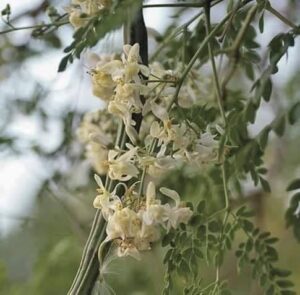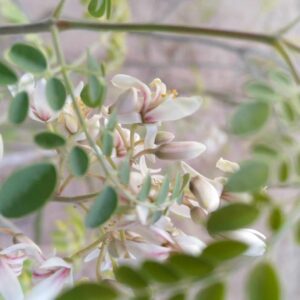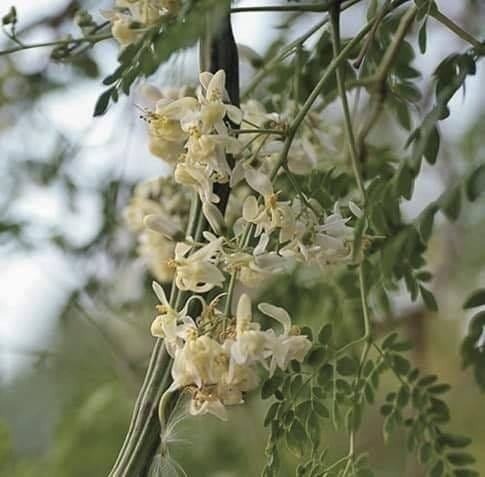Moringa Flowers
Step into the enchanting realm of Moringa flowers, the hidden gems of the Moringa oleifera tree! In this article, we’ll take you on a journey through the mesmerizing world of these delicate blossoms, uncovering their beauty, health benefits, and culinary delights. But it doesn’t stop there – we’ll also delve into their rich cultural history and their crucial role in supporting our environment.
Prepare to be captivated by the vibrant colors and unique shapes of Moringa flowers. We’ll show you how these blooms have been revered for centuries in various cultures, with deep symbolism and significance in traditional practices and ceremonies. As we unravel the secrets of these exquisite blossoms, you’ll be amazed at the treasure trove of vitamins, minerals, and health-promoting compounds they hold.
Get ready for a culinary adventure like no other as we explore the amazing flavors and textures Moringa flowers can bring to your plate. From ancient recipes to modern gastronomic delights, you’ll be delighted by the surprising versatility of these blooms in the kitchen.
But Moringa flowers are not just about appearances and taste – they are eco-friendly superheroes! We’ll show you how the Moringa tree and its blossoms play a vital role in environmental conservation, promoting soil health, and supporting biodiversity. Discover how Moringa cultivation can be a key player in mitigating climate change and building a more sustainable future for our planet.
For all you green thumbs out there, we’ve got you covered! Our comprehensive guide will help you grow and care for Moringa flowers, so you can bring their magical beauty to your own garden. From nurturing young saplings to harvesting the blooms, we’ll provide you with the knowledge and tools you need to cultivate these natural wonders.
And that’s not all – we’ll also peek into the future and explore the ongoing research and innovations related to Moringa flowers. Exciting possibilities await these floral wonders, and we’ll share how they might find their way into various industries, enriching our lives in unexpected ways.
So, come along on this fascinating journey of discovery, as we celebrate the splendor of Moringa flowers and the incredible contributions they make to our planet’s natural wonders. Let’s embrace, appreciate, and protect the beauty and benefits of these marvelous blooms, a testament to the wonders of nature!
A Blossoming Beauty: The Moringa Flower’s Appearance and Symbolism
In the enchanting world of Moringa flowers, nature bestows upon us a true spectacle of beauty. Delicate and alluring, these blossoms emerge as a testament to the marvels of the Moringa oleifera tree. Their splendor lies in their vibrant colors, graceful shape, and ethereal fragrance.
Imagine gazing upon Moringa flowers for the first time, their vivid hues capturing your senses in a spellbinding dance of colors. Ranging from pure white to soft pink and deep crimson, these blossoms adorn the Moringa tree like precious jewels, beckoning us to marvel at their captivating allure.
But it’s not just their appearance that makes Moringa flowers extraordinary; they carry profound symbolism across different cultures and traditions.
Revered as symbols of purity, love, and beauty, these blooms have played significant roles in ceremonies, rituals, and celebrations throughout history.
In some cultures, people associate Moringa flowers with fertility and new beginnings, often using them to mark joyous occasions like weddings and births. On the other hand, they might symbolize mourning and remembrance, finding their place in rituals that commemorate departed loved ones.
The spiritual significance of Moringa flowers is mirrored in various religious practices as well. In certain belief systems, these blossoms are revered as offerings to deities, reflecting the interconnectedness between nature and spirituality.
Beyond their cultural symbolism, Moringa flowers hold personal meaning for many, acting as poignant reminders of love, hope, and resilience. The sight of these blooms can uplift spirits, evoking a sense of wonder and appreciation for life’s delicate wonders.
As we delve deeper into the symbolic language of Moringa flowers, we come to understand their profound connection with nature’s cycles. Just like the tree itself, these blossoms embody growth, renewal, and the continuous circle of life.

The Nutritional and Medicinal Marvels of Moringa Flowers
Amidst their captivating beauty, Moringa flowers conceal a treasure trove of nutritional and medicinal wonders. Beyond their aesthetic appeal, these delicate blossoms hold a wealth of health-promoting compounds that have been cherished for centuries in traditional medicine practices.
Let’s uncover the nutritional powerhouse that Moringa flowers truly are.
Bursting with essential vitamins like vitamin C, vitamin A, and vitamin E, these blooms pack a punch when it comes to supporting our immune system and promoting overall well-being.
Their rich mineral content, including calcium, potassium, and iron, also contributes to strengthening bones and regulating blood pressure.
Nutritional Profile of Moringa Flowers
| Nutrient | Amount per 100g |
|---|---|
| Vitamin C | 220 mg |
| Vitamin A | 6,000 IU |
| Vitamin E | 48 mg |
| Calcium | 440 mg |
| Potassium | 259 mg |
| Iron | 7 mg |
| Protein | 6.7 g |
| Dietary Fiber | 2 g |
| Total Carbohydrates | 23.2 g |
| Total Fat | 1.7 g |
But the real superstar in Moringa flowers lies in their abundance of antioxidants. These powerful compounds act as warriors against free radicals, protecting our cells from oxidative stress and reducing the risk of chronic diseases. Embracing Moringa flowers in our diet can be a fantastic way to boost our body’s natural defense mechanisms.
In traditional medicine, Moringa flowers have been highly regarded for their medicinal properties. Their anti-inflammatory and antimicrobial attributes have been used to alleviate various ailments, from minor skin irritations to more significant health concerns. In certain cultures, the flowers are infused into teas or applied topically to promote wound healing and soothe skin conditions.
Moreover, Moringa flower extracts have shown promising potential in managing blood sugar levels, making them an interesting subject of study for diabetes management. Researchers are also exploring their impact on cardiovascular health and cholesterol regulation, hinting at the possibility of new therapeutic avenues.
For women’s health, Moringa flowers have historically been used to ease menstrual discomfort and hormonal imbalances. Their soothing and calming properties provide much-needed relief during challenging times.
In Ayurvedic medicine, practitioners believe that Moringa flowers play a versatile role by balancing the body’s doshas and enhancing vitality. Ayurvedic practitioners have utilized these blooms to invigorate the body and promote overall well-being.
As we uncover the nutritional and medicinal marvels of Moringa flowers, we come to appreciate the depth of their contributions beyond mere aesthetics. Their healing potential and nourishing properties invite us to incorporate them into our diets and explore their various applications in traditional medicine.
In conclusion, Moringa flowers embody the remarkable synergy of nature’s beauty and health benefits. Their nutritional richness and therapeutic attributes make them more than just a pretty sight – they hold the promise of enhancing our well-being and enriching our lives with their abundant goodness. So, next time you marvel at the enchanting blooms of the Moringa tree, remember the incredible secrets they carry within, waiting to be embraced and cherished for their nutritional and medicinal marvels.

Culinary Adventures: Moringa Flowers on the Plate
Prepare your taste buds for an extraordinary culinary journey as we explore the delightful world of Moringa flowers in the kitchen. These exquisite blooms not only mesmerize with their beauty but also add a touch of unique flavor and texture to a wide array of dishes, making them a true culinary gem.
In many cultures where “Miracle Trees” thrive, the flowers have been a part of traditional recipes for generations. They boast a subtle, mildly sweet taste, which makes them perfect for both savory and sweet dishes. Some describe their flavor as a delicate combination of green peas and mushrooms, lending a delightful twist to culinary creations.
One of the simplest ways to savor Moringa flowers is by incorporating them into salads. The tender blooms add a pop of color and a refreshing taste, elevating the salad’s overall appeal. In addition, the flowers can be lightly sautéed or stir-fried with other vegetables, creating a delectable and nutritious side dish bursting with flavors.
For those with a sweet tooth, Moringa flowers can be a surprising addition to desserts. Imagine indulging in cakes, muffins, or even ice creams adorned with these delicate blooms. The subtle sweetness of the flowers beautifully complements the sugary goodness of desserts, leaving a lasting impression on your palate.
Some cultures use Moringa flowers to prepare flavorful herbal teas. These teas are not only soothing but also brimming with the health benefits of the flowers’ nutritional components. It’s a delightful way to experience the gentle taste of Moringa while nurturing your body.
But the culinary adventure doesn’t end with modern recipes; traditional cuisines offer a treasure trove of culinary wisdom involving Moringa flowers. Chefs and cooks have expertly incorporated Moringa flowers into diverse dishes, passing down these culinary traditions through generations and cherishing their taste and nourishing qualities.
Moringa flowers’ versatility in the kitchen sparks creativity among chefs and home cooks alike. Their ability to blend seamlessly with both savory and sweet flavors opens up a world of possibilities in the culinary realm.
However, it is essential to remember that not all Moringa species produce edible flowers. When experimenting with Moringa flowers in the kitchen, ensure that you are using flowers from the Moringa oleifera tree or a species known to be safe for consumption.

Which Moringa Species Flowers are not Edible?
How Many Species of Moringa Are There?
Among the various Moringa species, the flowers of Moringa stenopetala and drouhardii are generally not considered edible. Unlike Moringa oleifera, which is the most commonly cultivated species for its edible parts, including leaves, pods, and flowers, these other species have different properties and may not be safe or suitable for consumption.
Moringa stenopetala, also known as African Moringa or the African horseradish tree, is native to parts of Ethiopia and Kenya. While some cultures utilize it for traditional medicinal purposes, people generally do not commonly incorporate its flowers and other parts into culinary dishes, and the safety of consuming these parts is not well-established.
Moringa drouhardii, commonly known as “Forest Moringa,” is native to Madagascar and other parts of the Indian Ocean region. People do not typically consume its flowers, leaves, and other parts, and its use is primarily ornamental or for traditional medicinal purposes in some cultures.
It’s essential to exercise caution when using any plant for culinary purposes, especially if it is not a widely recognized and consumed species. When exploring Moringa flowers for culinary use, it is best to stick with Moringa oleifera, which is the most well-researched and commonly used species for its edible and nutritious properties.
Sustainable Superstars: Environmental and Agricultural Importance

Beyond their enchanting beauty and culinary charm, Moringa flowers and the Moringa oleifera tree as a whole emerge as true sustainable superstars, playing a vital role in environmental and agricultural spheres.
Moringa trees have gained recognition for their exceptional ability to thrive in diverse environments, even in harsh conditions with minimal water availability. Their resilience and fast growth make them a valuable asset in reforestation efforts and combating deforestation. By planting Moringa trees, we can restore degraded lands, protect soil from erosion, and promote ecological balance.
One of the most extraordinary contributions of Moringa Trees is their impact on climate change mitigation. These trees possess a remarkable capacity to absorb carbon dioxide from the atmosphere, acting as effective carbon sinks. By sequestering carbon, Moringa trees help offset greenhouse gas emissions, which is a significant step in addressing the global climate crisis.
Additionally, Moringa trees provide valuable sustenance for both humans and animals. The leaves, flowers, and pods are all edible and rich in essential nutrients, making them a nutritious food source in regions where malnutrition is a concern. Moreover, farmers can use Moringa leaves as livestock feed, supporting animal health and providing economic opportunities.
Moringa’s agricultural importance extends to its role in improving soil fertility. The fallen leaves and flowers of the Moringa tree act as natural fertilizers, enriching the soil with nutrients and enhancing its productivity. This natural fertilizer not only reduces the need for chemical fertilizers but also promotes sustainable and eco-friendly farming practices.
Furthermore, people can use the Moringa tree’s seeds, which contain high-quality oil, for various purposes. Moringa oil serves as a renewable source of biodiesel, offering an eco-friendly alternative to fossil fuels. The oil extraction process generates byproducts that farmers can use as organic fertilizers, further contributing to sustainable agriculture.
The utilization of Moringa trees and their flowers in sustainable practices aligns perfectly with the principles of agroforestry. Integrating Moringa trees into farming systems promotes biodiversity, provides shade for other crops, and encourages ecological harmony.
In conclusion, Moringa flowers and the Moringa oleifera tree prove to be sustainable superstars, offering solutions to pressing environmental and agricultural challenges. Their ability to thrive in adverse conditions, sequester carbon, enrich soil, and provide valuable resources for human and animal consumption makes them a remarkable ally in creating a sustainable future.

Growing and Caring for Moringa Flowers: A Green Thumb Guide
If you’re a gardening enthusiast who is eager to bring the magic of Moringa flowers into your own backyard, this green thumb guide will provide you with all the information you need! Growing Moringa flowers is a rewarding experience, and with a little know-how, you can nurture these blooms to flourish and grace your garden with their splendor.
- Choosing the Right Location: Moringa trees thrive in warm, sunny climates, so choose a spot in your garden that receives plenty of sunlight. They can tolerate a range of soil types, but well-draining soil with a slightly acidic to neutral pH is ideal for optimal growth.
- Starting from Seeds or Cuttings: You have two options when it comes to planting Moringa – either from seeds or cuttings. If you choose seeds, soak them in water for 24 hours before planting to enhance germination. When using cuttings, make sure to take them from healthy, mature branches to maximize the chances of success.
- Planting and Watering: When planting seeds or cuttings, dig a hole large enough to accommodate the roots and backfill it with soil. Water the newly planted Moringa tree generously to help it establish its roots. While Moringa trees are drought-tolerant, they benefit from regular watering, especially during the early stages of growth.
- Pruning for Optimal Growth: Regular pruning is essential to encourage healthy growth and flowering. Trim the tree’s branches to maintain a balanced and manageable shape. Additionally, pruning helps the tree focus its energy on producing more flowers.
- Fertilization: These trees respond well to organic fertilizers, and their fallen leaves and flowers act as natural fertilizers too. However, avoid using excessive nitrogen-based fertilizers, as this might lead to more foliage growth and fewer flowers.
- Harvesting Moringa Flowers: Once your “Miracle Tree” matures, it will begin to produce lovely flowers. Harvest the blossoms when they are fully open but still fresh and tender. Be gentle when plucking the flowers to avoid damaging the tree.
- Preserving Freshness: Moringa flowers have a relatively short shelf life, so if you’re not using them immediately, store them in the refrigerator in a damp paper towel to maintain their freshness for a few days.
- Dealing with Challenges: While Moringa trees are relatively hardy, they can be susceptible to pests and diseases. Keep an eye out for common issues like aphids, caterpillars, or fungal infections, and address them promptly with organic pest control methods.
By following these green thumb guidelines, you’ll be well on your way to cultivating a flourishing Moringa tree that graces your garden with its beautiful flowers. Remember, patience and care are the keys to successfully growing Moringa flowers and reaping the rewards of this magical plant’s beauty and nourishment. Happy gardening!
| Attribute | Information |
|---|---|
| Common Name | Moringa plant, moringa tree, miracle tree, horseradish tree, drumstick tree, ben oil tree |
| Botanical Name | Moringa oleifera |
| Family | Moringaceae |
| Plant Type | Tree |
| Mature Size | 25-35 ft. tall, 15-25 ft. wide |
| Sun Exposure | Full |
| Soil Type | Loamy, sandy, well-drained |
| Soil pH | Neutral, acidic |
| Bloom Time | Spring |
| Flower Color | White |
| Hardiness Zones | 10-11 (USDA) |
| Native Area | Asia |
The Future of Moringa Flowers: Research and Innovation
As the world continues to explore the potential of Moringa flowers, exciting research and innovation pave the way for their future applications. Skincare product manufacturers are incorporating extracts from these blooms, thanks to their antioxidant-rich content and ability to soothe and rejuvenate the skin.
- Advancements in Health and Wellness: Researchers are delving deeper into the medicinal properties of Moringa flowers, seeking to unlock their full therapeutic potential. Studies focus on identifying specific bioactive compounds that contribute to their health benefits, paving the way for new herbal remedies and natural supplements.
- Beauty and Skincare: The cosmetic industry is also taking notice of the nourishing properties of Moringa flowers. Skincare product manufacturers are incorporating extracts from these blooms, thanks to their antioxidant-rich content and ability to soothe and rejuvenate the skin. As consumers seek more sustainable and plant-based options, Moringa flowers are likely to become an essential ingredient in beauty formulations.
- Culinary Innovation: Chefs and food enthusiasts are continually experimenting with new culinary delights, and Moringa flowers present a tantalizing opportunity. Their unique taste and nutritional profile make them a sought-after ingredient in modern gastronomy. As culinary trends evolve, we can anticipate that chefs and food enthusiasts will showcase Moringa flowers in innovative dishes and incorporate them as a staple in restaurant menus.
- Sustainable Agriculture and Food Security: With the world’s population on the rise, ensuring food security is a pressing concern. Moringa trees and their edible flowers offer a valuable solution, providing a source of nutritious food even in regions with limited resources. As global awareness grows about the importance of sustainable agriculture, Moringa flowers’ role in enhancing food security is likely to expand.
- Biofuel and Renewable Energy: People have long valued Moringa trees for their seeds, which produce high-quality oil suitable for biodiesel production. As the world seeks to transition to renewable energy sources, Moringa flowers may find themselves contributing significantly to the biofuel industry, offering a sustainable alternative to fossil fuels.
- Environmental Conservation: The environmental benefits of Moringa trees and their flowers are gaining attention, with potential applications in reforestation efforts and ecological restoration. As climate change continues to pose challenges, Moringa’s role as a carbon sink and soil enricher positions it as a valuable tool in mitigating environmental impact.
- Traditional and Indigenous Knowledge: As Moringa flowers gain global recognition, there is a growing interest in preserving and respecting traditional knowledge surrounding their use. Working collaboratively with indigenous communities ensures the conservation of cultural practices and the sustainable utilization of Moringa flowers.
Conclusion
In the enchanting world of this Miracle Tree, we have embarked on a journey of discovery, marveling at the splendor and significance of these delicate blooms. Beyond their captivating beauty, Moringa flowers hold a wealth of treasures, offering a symphony of health benefits, culinary delights, and sustainable solutions.
As we unraveled the nutritional and medicinal marvels of Moringa flowers, we came to appreciate their potent role in supporting our well-being. From essential vitamins and minerals to powerful antioxidants, these blooms proved themselves as a true gift from nature, nourishing both body and soul.
Venturing into the culinary adventures, we delighted in their versatile flavors and textures. From salads to desserts, Moringa flowers wove their magic into dishes, inviting us to savor the delectable taste of nature’s bounty.
But Moringa flowers are more than just a feast for our senses; they are sustainable superstars in their own right. Through their resilience, carbon sequestration, and soil-enriching properties, Moringa trees emerged as champions in environmental conservation and agricultural advancement.
The future of Moringa flowers shines brightly with ongoing research and innovation. Moringa flowers, spanning from health and wellness to skincare, and from food security to renewable energy, stand ready to leave an indelible mark on diverse industries by actively supporting sustainable practices and nourishing our planet.
As we conclude this journey, let us remember the deeper significance of Moringa flowers beyond their nutritional and environmental prowess. Their rich cultural symbolism and ancient ties to tradition remind us of the timeless connections between humanity and nature.
Embracing the magic of Moringa flowers invites us to cherish the wonders of our natural world and to safeguard its delicate balance. By nurturing Moringa trees and treasuring their precious blooms, we become custodians of nature’s gifts, fostering a future where beauty, health, and sustainability thrive hand in hand.
So, let us celebrate the marvels of Moringa flowers, and may their beauty continue to inspire us to appreciate, protect, and coexist harmoniously with the wonders of nature. Together, we can cultivate a world where Moringa flowers flourish, gifting us not only with their enchanting allure but also with a sustainable future of abundance and well-being.
References
https://www.medicalnewstoday.com/articles/319916
https://www.webmd.com/vitamins/ai/ingredientmono-1242/moringa
Moringa With Barry stores offer a variety of moringa products. These include: Moringa Powder, Moringa Tea, Moringa Capsules and Moringa Oil.




